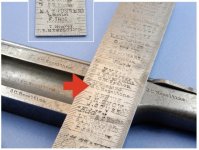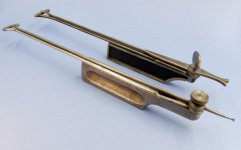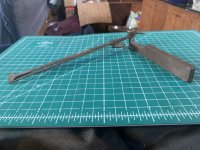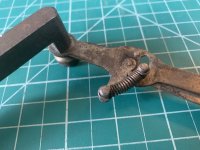rivett608
Diamond
- Joined
- Oct 25, 2002
- Location
- Kansas City, Mo.
Here are 2 posts this week from my IG and FB feeds I think you will like…
A tale of two 100 year old machinists indicators, well sort of, except there is so much that remains unknown. What is known is these are “shop made” test indicators for centering work on a lathe. The term “shop made” is used because they were made by the machinist who used them as opposed to a factory produced product from some big company. These were sometimes made as trade school projects by apprentices learning their trade or machinists working from drawings published in a trade magazine such as American Machinist. What is interesting about these two is they were made by 2 different craftsman working from the same drawings or design, each adding their own flair. One has a milled body with a turned and knurled knob, the other a cast body with a forged and filed thumbscrew. They both appear to have a cast and filed arms with similar but differently shaped scales on the far end. The spring on one is beautifully formed and dovetailed in place where the other uses two pieces of spring wire swaged into position. If these were school projects it would be easy to see who I would give the higher grade too.
Some may need an explanation of how they are used since this type indicator I don’t think has been commercially produced in at least 50 years. They work by mounting the body in a rocker style tool post on a lathe and holding the tip against the work to trued up in a chuck or between centers. The roughly 10 to 1 ratio between the contact tip and pointer greatly amplifies any movement on the scale at the far end.
One of the indicators has the owner, who was most likely the maker, name stamped on it, J. C. HESELTINE. He was so proud of this he stamped in 8 places with his custom made stamp. That is where this story gets fun. Back up about 25 years I got a Darling Brown & Sharpe (1866-1892) 6” rule to add to my collection. But this no ordinary rule, it was likely owned by a “Stamp Maker” who used it to test over a 100 of his finished name stamps. Stamp making was a highly specialized trade and most of the work was done with a file. There is very little written in the period as to how this was done and most machinists did not make their own. It was very common for machinists and other tradesman to mark their names on their tools and since these tools are often made of hardened steel testing a new stamp on a tool would make perfect sense. It is not known who’s rule this was but it is probably from New England. In 25+ years I have only seen one other tool, it was a whole chest I sold to the NPS for the restoration of Thomas Edison’s Lab in West Orange, NJ. It was owned by E.L. Starr.
A couple weeks ago I was scrolling eBay as I often do and came across this indicator. In the back of my mind I thought the named seemed familiar. After a quick check of the rule it was, in the middle of of one side is J.C. HESELTINE, see red arrow. But that is not all, on the other side at the bottom is J.R. HESELTINE, could have that been a father, a brother? One more mystery we will probably never know.
Wil Heitritter from FB wrote this!
"Wow, I love it! I couldn't stand the mystery, though: Found some good candidates: John Chester Heseltine (1875-1923), a toolmaker in Hampden, MA, in 1920. His grandfather, John Ruel Heseltine (1828-1890), engineer, Boston." I think that is our guy! Thank you Wil!
A tale of two 100 year old machinists indicators, well sort of, except there is so much that remains unknown. What is known is these are “shop made” test indicators for centering work on a lathe. The term “shop made” is used because they were made by the machinist who used them as opposed to a factory produced product from some big company. These were sometimes made as trade school projects by apprentices learning their trade or machinists working from drawings published in a trade magazine such as American Machinist. What is interesting about these two is they were made by 2 different craftsman working from the same drawings or design, each adding their own flair. One has a milled body with a turned and knurled knob, the other a cast body with a forged and filed thumbscrew. They both appear to have a cast and filed arms with similar but differently shaped scales on the far end. The spring on one is beautifully formed and dovetailed in place where the other uses two pieces of spring wire swaged into position. If these were school projects it would be easy to see who I would give the higher grade too.
Some may need an explanation of how they are used since this type indicator I don’t think has been commercially produced in at least 50 years. They work by mounting the body in a rocker style tool post on a lathe and holding the tip against the work to trued up in a chuck or between centers. The roughly 10 to 1 ratio between the contact tip and pointer greatly amplifies any movement on the scale at the far end.
One of the indicators has the owner, who was most likely the maker, name stamped on it, J. C. HESELTINE. He was so proud of this he stamped in 8 places with his custom made stamp. That is where this story gets fun. Back up about 25 years I got a Darling Brown & Sharpe (1866-1892) 6” rule to add to my collection. But this no ordinary rule, it was likely owned by a “Stamp Maker” who used it to test over a 100 of his finished name stamps. Stamp making was a highly specialized trade and most of the work was done with a file. There is very little written in the period as to how this was done and most machinists did not make their own. It was very common for machinists and other tradesman to mark their names on their tools and since these tools are often made of hardened steel testing a new stamp on a tool would make perfect sense. It is not known who’s rule this was but it is probably from New England. In 25+ years I have only seen one other tool, it was a whole chest I sold to the NPS for the restoration of Thomas Edison’s Lab in West Orange, NJ. It was owned by E.L. Starr.
A couple weeks ago I was scrolling eBay as I often do and came across this indicator. In the back of my mind I thought the named seemed familiar. After a quick check of the rule it was, in the middle of of one side is J.C. HESELTINE, see red arrow. But that is not all, on the other side at the bottom is J.R. HESELTINE, could have that been a father, a brother? One more mystery we will probably never know.
Wil Heitritter from FB wrote this!
"Wow, I love it! I couldn't stand the mystery, though: Found some good candidates: John Chester Heseltine (1875-1923), a toolmaker in Hampden, MA, in 1920. His grandfather, John Ruel Heseltine (1828-1890), engineer, Boston." I think that is our guy! Thank you Wil!




 ........I still have my old lathe centre finder (sorta poor mans Starrett #65 based around a 5/16 (I think) phos bronze ball) from 45 + years ago, .......and it still gets used.
........I still have my old lathe centre finder (sorta poor mans Starrett #65 based around a 5/16 (I think) phos bronze ball) from 45 + years ago, .......and it still gets used.



